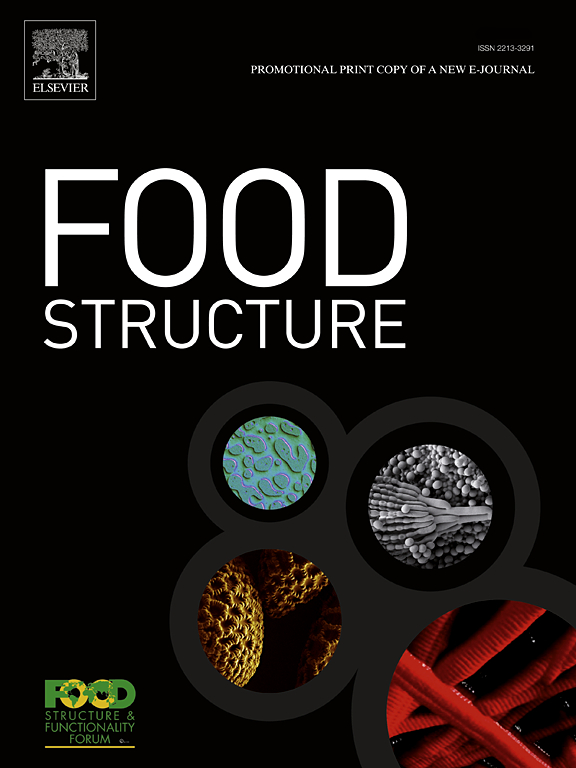牛肉的细胞外基质:对培养肉的三维支架的表征
IF 5.9
3区 农林科学
Q1 FOOD SCIENCE & TECHNOLOGY
引用次数: 0
摘要
培养肉制品中肌肉细胞生长的支架开发需要了解牛肌肉组织中细胞外基质(ECM)的机械特性。然而,以前的研究主要集中在非牛样品上,并通过将其加工成水凝胶来改变天然ECM结构。本研究表征了牛肌肉组织的天然ECM,为设计ECM替代品提供参考数据,同时保留其结构和力学特征。方案针对薄样品(~ 1.5 mm)进行了优化,与目前正在开发的培养肉制品相对应。用0.5 % SDS脱细胞法从新鲜牛里脊和里脊中分离出ECM。进行了广泛的样品质量验证,包括冷冻扫描电镜(cryo-SEM)来观察内部结构,Picogreen分析来量化残余的dsDNA并确认有效的细胞去除,以及蛋白质组学和糖胺聚糖分析来验证基本ECM成分的保留。随后的力学分析包括振幅扫描(G′,G′,线性粘弹性区域,交叉点)和织构分析(总拉伸,最大载荷)。结果证实了有效的脱细胞,保持了ECM的结构和成分的完整性。牛里脊肉和里脊肉的储存模量(G′)分别为15.2 kPa和12.3 kPa,而脱细胞里脊肉的储存模量分别为0.3 kPa和1.0 kPa (p <; 0.001)。织构分析显示没有显著差异,表明ECM主要决定了这些特性。最大载荷为1.4 ~ 3.1 N,总延伸量为9.2 ~ 11.6 mm。这些发现为复制天然ECM特性的支架提供了参考数据,并为培养肌纤维构建体建立了目标力学性能。本文章由计算机程序翻译,如有差异,请以英文原文为准。
The extracellular matrix of beef: A characterization towards a 3D scaffold for cultured meat
Scaffold development for muscle cell growth in cultured meat production requires understanding the mechanical properties of the extracellular matrix (ECM) in bovine muscle tissue. However, previous studies have focused on non-bovine samples and have altered the native ECM structure by processing it into hydrogels. This study characterizes the native ECM of bovine muscle tissues, providing reference data for designing ECM alternatives while preserving its structural and mechanical features. Protocols were optimized for thin samples (∼ 1.5 mm), corresponding to the cultured meat products currently under development. ECM was isolated from fresh bovine sirloin and tenderloin using 0.5 % SDS for decellularization. An extensive sample quality validation was performed, including cryo-SEM to visualize internal structures, Picogreen assays to quantify residual dsDNA and confirm effective cell removal, and proteomic and glycosaminoglycan analyses to verify retention of essential ECM components. Subsequent mechanical analyses included amplitude sweeps (G’, G’’, linear visco-elastic region, cross-over point) and texture analyses (total extension, maximal load). Results confirmed efficient decellularization, preserving the ECM’s structural and compositional integrity. The storage modulus (G’) was 15.2 kPa for sirloin and 12.3 kPa for tenderloin, decreasing significantly to 0.3 kPa (p < 0.01) and 1.0 kPa (p < 0.001) for their decellularized counterparts. Texture analyses revealed no significant differences, suggesting ECM primarily determines these properties. Maximal load ranged from 1.4 N to 3.1 N, while total extension varied between 9.2 mm and 11.6 mm. These findings provide reference data for scaffolds replicating natural ECM properties and establish target mechanical properties for cultured muscle fiber constructs.
求助全文
通过发布文献求助,成功后即可免费获取论文全文。
去求助
来源期刊

Food Structure-Netherlands
Chemical Engineering-Bioengineering
CiteScore
7.20
自引率
0.00%
发文量
48
期刊介绍:
Food Structure is the premier international forum devoted to the publication of high-quality original research on food structure. The focus of this journal is on food structure in the context of its relationship with molecular composition, processing and macroscopic properties (e.g., shelf stability, sensory properties, etc.). Manuscripts that only report qualitative findings and micrographs and that lack sound hypothesis-driven, quantitative structure-function research are not accepted. Significance of the research findings for the food science community and/or industry must also be highlighted.
 求助内容:
求助内容: 应助结果提醒方式:
应助结果提醒方式:


